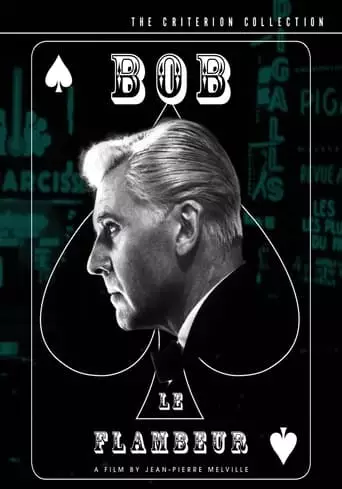In Paris, Bob Montagne is practically synonymous with gambling — and winning. He is kind, classy and well-liked by virtually everyone in town, including police inspector Ledru. However, when Bob’s luck turns sour, he begins to lose friends and makes the most desperate gamble of his life: to rob the Deauville casino during Grand Prix weekend, when the vaults are full. Unfortunately, Bob soon learns that the game is rigged and the cops are on to him.
Bob le Flambeur is a seminal French crime film directed by Jean-Pierre Melville in 1956. The title translates to Bob the Gambler, encapsulating the essence of the protagonist, Bob Montagne, portrayed by Roger Duchesne. Bob is a seasoned gambler residing in the Montmartre district of Paris, leading a life characterized by routine and a sense of nostalgia for his past exploits.
The narrative unfolds as Bob, despite his age and previous criminal endeavors, plans a high-stakes heist targeting a Deauville casino. He assembles a team, including his friend Paul (André Garet), a young accomplice named Roger (Daniel Cauchy), and a woman named Anne (Isabelle Corey), who becomes romantically involved with Roger. As the heist approaches, unforeseen complications arise, leading to a series of events that test the characters’ resolve and morality.
Melville’s direction is marked by a meticulous attention to detail and a deep understanding of the crime genre. The film’s pacing and structure reflect a blend of suspense and character study, offering a nuanced portrayal of individuals entangled in the criminal underworld. The cinematography by Henri Decaë captures the atmospheric essence of Paris, juxtaposing the city’s vibrant life with the shadows of its criminal elements.
Main Themes in Bob le Flambeur
- Nostalgia and the Past
Bob’s character is deeply influenced by his past, reflecting a longing for the days when he was a prominent figure in the criminal world. This theme explores the tension between past glory and present reality, highlighting how memories can shape one’s identity and decisions.
- Morality and Redemption
The film delves into the moral complexities of its characters, particularly Bob, who exhibits a code of honor despite his criminal activities. This theme examines the possibility of redemption and the internal struggles individuals face when reconciling their past actions with their desires for change.
- Chance and Fate
Gambling serves as a central motif, symbolizing the role of chance in the characters’ lives. The film portrays how fate and luck intertwine, influencing outcomes and revealing the unpredictability inherent in human endeavors.
- Urban Isolation
Despite the bustling setting of Paris, the characters experience a profound sense of isolation. This theme explores the loneliness that can pervade urban life, even among individuals who are part of a close-knit community, highlighting the existential solitude of the human condition.
Impact of Bob le Flambeur
Bob le Flambeur holds a significant place in cinematic history, particularly in the crime genre. Its innovative narrative structure and character development have influenced numerous filmmakers. The film’s exploration of moral ambiguity and its portrayal of the criminal underworld have left a lasting imprint on cinema. Its influence is evident in later works, including Steven Soderbergh’s Ocean’s Eleven, which drew inspiration from Melville’s approach to heist storytelling.
7 Reasons to Watch Bob le Flambeur
- Masterful Direction by Jean-Pierre Melville
Melville’s direction is a testament to his expertise in the crime genre. His meticulous attention to detail and atmospheric storytelling create a compelling narrative that keeps viewers engaged from start to finish.
- Complex and Engaging Plot
The film’s intricate storyline, filled with twists and turns, challenges viewers to pay close attention to every detail. This complexity enhances the viewing experience, offering a rewarding narrative for those who appreciate layered storytelling.
- Strong Performances by the Cast
The ensemble cast delivers exceptional performances, bringing depth and authenticity to their characters. Roger Duchesne’s portrayal of Bob and Isabelle Corey’s depiction of Anne are particularly noteworthy, showcasing their range and commitment to their roles.
- Influential Cinematic Style
Bob le Flambeur is a quintessential example of French noir, with its moody cinematography, use of shadows, and atmospheric settings. These stylistic elements have influenced countless films and are a visual treat for cinephiles.
- Exploration of Timeless Themes
The film delves into universal themes such as nostalgia, morality, and the role of chance, offering a profound commentary on human nature. These themes resonate across cultures and eras, making the film’s message enduring and impactful.
- Cultural and Historical Significance
As a product of mid-20th-century French cinema, Bob le Flambeur provides insight into the cultural and social dynamics of the time. Its portrayal of Parisian life and the criminal underworld offers a window into the era’s societal issues and cinematic trends.
- Critical Acclaim and Legacy
The film has received critical acclaim for its storytelling, direction, and performances. Its legacy continues to be celebrated, with retrospectives and analyses highlighting its importance in the crime genre. Watching Bob le Flambeur allows viewers to experience a piece of cinematic history that has stood the test of time.
How Will You Feel After Watching Bob le Flambeur (1956)?
After viewing Bob le Flambeur, you will likely experience a sense of admiration for its intricate storytelling and atmospheric direction. The film’s exploration of complex themes such as nostalgia, morality, and the role of chance will provoke deep reflection on human nature and the choices individuals make. The strong performances by the cast, particularly Roger Duchesne and Isabelle Corey, will leave a lasting impression, showcasing the depth and authenticity they bring to their roles.
The film’s stylistic elements, including its moody cinematography and use of shadows, will immerse you in the noir aesthetic, evoking a sense of nostalgia for classic crime cinema. The intricate plot, filled with twists and turns, will keep you engaged, prompting you to reconsider earlier scenes and dialogue in light of the film’s conclusion.

